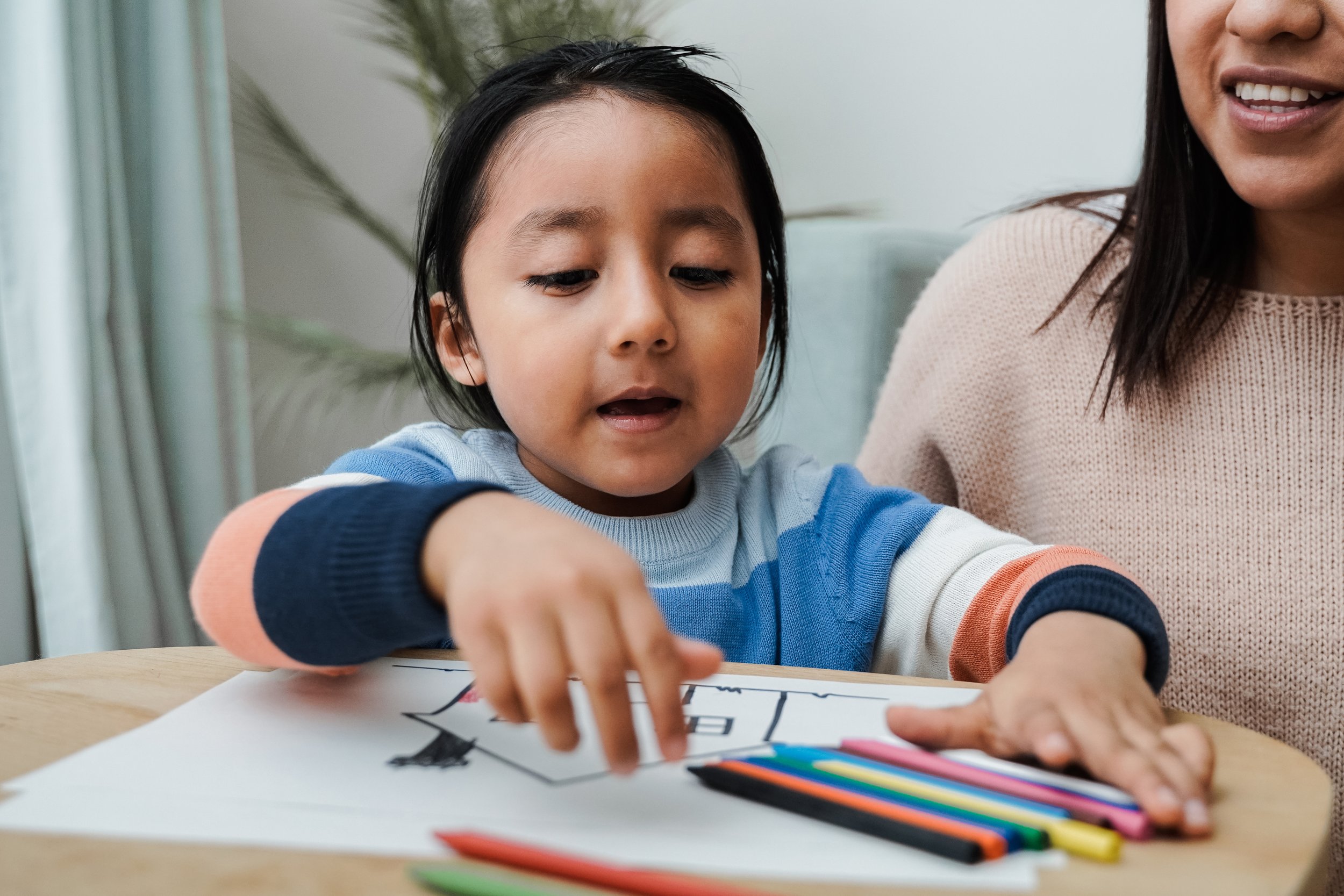Final Consonant Deletion
Help! My Toddler Is Leaving Sounds Off At The Ends Of Words
As speech language pathologists we often hear parents’ concerns about their little one leaving the sounds off the ends of words.
But it’s not necessarily something to worry about as your toddler is learning to talk.
In speech therapy, we refer to this toddler speech “error” of leaving consonant sounds off the ends of words as final consonant deletion. It’s one of many phonological processes, or predictable speech errors toddlers use to simplify words that are too hard for them to say right now.
Our goal for this post is to give you some ideas for how you can teach your little one to say the sounds at the ends of words (when they are ready of course). But first we’ll cover:
Final Consonant Deletion Words
We’ve already mentioned that final consonant deletion is a speech pattern in which toddlers leave the consonant sound off the end of words. But we often find that examples are most helpful in understanding toddler’s speech patterns.
Here are some examples; final consonant deletion can happen when your little one is saying one word at a time or when they are talking in sentences.
| Word | Word With Final Consonant Deletion |
|---|---|
| Cat | Ca |
| Dog | Do |
| Fish | Fi |
| Wait | Wai |
| Mom | Ma |
| Kid | Ki |
| Word | Example in Sentence | |
|---|---|---|
| Want | I wan a cookie. | |
| Dad | I love my Da! | |
| Set | Read Se Go! |
What causes final consonant deletion?
Final consonant deletion is expected in 1 and 2 year olds. It happens as a result of a child’s developing speech system.
As children learn to talk they are learning not only how to pronounce different sounds, but also how to pronounce different sounds in different combinations. As speech therapists we refer to the different ways you can combine sounds as different word shapes.
Toddler’s first words generally follow the simplest word shapes and more challenging word shapes (like consonant + vowel + consonant words) emerge as they get more practice talking.
If your curious which word shapes are relatively easy or hard to pronounce here are a few rules of thumb.
The more sounds you put together the harder it is for children to pronounce those words.
Pronouncing a consonant sound at the end of a word is harder than pronouncing a vowel sound at the end of a word.
And here are some examples of word shapes:
| Word Shape | Example Words | |
|---|---|---|
| Consonant + Vowel | Ma, Pa, Moo, Boo, Ba, No, Two | |
| Vowel + Consonant | Up, On, Off | |
| Consonant + Vowel + Consonant + Vowel | Mama, Mommy, Papa, Daddy, Baby, Puppy | |
| Consonant + Vowel + Consonant | Cat, Sheep, Pop, Peek, Mom, Dad, Boat | |
At what age do toddlers outgrow final consonant deletion?
Usually children will naturally outgrow the process of final consonant deletion by the time they turn 3 years old.
So listen for your little one to start adding final consonants sometime before their 3rd birthday.
Why teaching final consonants is important
If children are 3 years or older and they leave the sound off the ends of words they may qualify for speech therapy to support their developing speech.
At this stage in language development, learning to pronounce final consonants becomes increasingly important. That’s because when children leave the consonant sound off the end of a word it is much more difficult to understand what they are saying.
For example, a child may know 7 words that start with “Ba” - Bag, Bat, Ball, Band, Bad, Bath, and Bass. But when they leave the consonants off the end, all 7 of these words are pronounce as “Ba.”
Caregivers and peers have to rely upon context clues to guess which of the 7 “Ba” words the child is trying to say - if they are playing soccer it’s likely that they are saying “ball.” Sometimes using context clues works, but not always.
If your child is trying to tell you about something that happened at preschool, it can be very frustrating for them if you don’t understand that their friend brought a singing bass in for show and tell.
As children’s vocabularies grow, it’s important to support their speech development, including the use of consonants at the ends of words, to ensure that other people can understand what they are saying.
Teaching Final Consonants: The #1 Rule
Let me start by saying that working on speech at home can be tricky because toddlers are also more likely to get frustrated when working on speech versus language.
When toddlers are trying really hard to pronounce specific words or sounds that they just can’t figure out it can be really frustrating! And when kids get upset it becomes much harder for them to learn; they may start avoiding practice all together. This is where speech therapists play a very important role in finding the speech strategies and activities that support your child in learning new skills without frustrating them.
So the #1 Rule for practicing final consonants at home is that your child must be having fun! If they aren’t having fun it’s a good indicator that a speech and language evaluation may be supportive for your little one.
Final Consonant Deletion Activities To Use At Home
Step 1. If your child is leaving consonants off the beginning or ends of words, I want you to first think of an activity your child enjoys and does every day. Here are some suggested activities: story time, taking a bath, snack time, getting dressed, clean up
Example: Taking a bath
Step 2. Next, think of all the sounds you know your child can pronounce and write them down. ** Or use our Pronunciation Profile Activity and we’ll walk you through the process of figuring out which specific sounds your child can say step by step 😊
Example: Consonant Sounds List: M, P, B, T, D, N, H, W
Step 3. Now, using only those sounds you wrote down, come up with three to five words that are related to that activity your child does everyday. And follow the consonant-vowel-consonant word shape.
Example: Mom, Pop, Hot, Tub, Mat, Hop
Step 4. Now, every day when you and your child do that activity, work those words into your speech repeatedly. Make sure your child can see your face when you say them so they can try to imitate you when they're ready.
Example: Sit on the floor beside the tub your child takes a bath and talk to them. Time to get in the tub! Let’s feel the water. Stick a finger in to feel the temperature. Is it hot? Nope, not too hot! The tub is ready. … Playing with toys in the tub. Pop pop pop the bubbles. The cow is jumping on the bubbles. The cow is popping them! Pop! You move the cow onto the edge of the tub. Hop hop hop JUMP! You say as the cow hops along the edge of the tub. The cow is on the edge again. Should the cow jump on the bath mat or into the tub? Mat or tub? …
Reminders:
Remember, don't make this a time to drill your child on saying words the right way. Because we've chosen words with only sounds they can already pronounce, the goal is to let your child hear these words enough times that they start to repeat them without your prompting.
Again, if you're concerned that your child isn’t using consonants at the ends of words, I strongly encourage you to seek the support of a speech therapist.
Final Consonant Deletion Words:
In order to help you create your lists for practice (remember just to pick a few at a time), here’s a list of even more consonant vowel consonant (CVC)words for toddlers:
CVC Words Ending In M
Mom, Yum, Him, Hum, Gum, Game
CVC Words Ending In P
Pop, Cap, Top, Tip, Mop, Hip, Lip, Cop, Rip, Zip, Dip
CVC Words Ending In B
Cub, Bob, Job, Bib, Bub, Web
CVC Words Ending In T
Bit, Bite, Fit, Hit, Lit, Pit, Pat, Pout, Cat, Sit, Rat, Mat, Bat, Boot, Toot
CVC Words Ending In D
Did, Hid, Kid, Lid, Bad, Mad, Sad, Rad, Had, Hood, Wood, Food
CVC Words Ending In N
Bin, Fin, Pin, Win, Pan, Fan, Ran, Spoon,
CVC Words Ending In K
Cook, Look, Pick, Lick, Sick, Pack, Sack, Wack,
CVC Words Ending In G
Big, Fig, Gig, Pig, Jig, Wig
Other Common Questions About Final Consonant Deletion
-
Final consonant deletion is a typical part of speech development. It’s expected that children use final consonant deletion at 1 and 2 years old. If children leave of final consonants after they turn 3 it can be classified as a “speech disorder” to qualify the child for speech therapy.
-
It depends. If a child is less than 3 years old it would be classified as an expected phonological process or phonological pattern.
For children 3 years and older final consonant deletion may be classified as a phonological disorder by a speech therapist if the child is consistently leaving consonants off the ends of words - this must be a clear pattern to be classified as a phonological disorder.
-
Yes, final consonant deletion is very common in 1 and 2 year old children who are learning to talk.
Written By:
Stephanie Keffer, MS CCC-SLP
© 2020-2025. Stephanie Keffer Hatleli, MS CCC-SLP. All Rights Reserved.
The content offered on ToddlerTalk.com is for informational purposes only. Toddler Talk is not engaged in rendering professional advice, whether medical or otherwise, to individual users or their children or families. No content on this site, regardless of date, should ever be used as a substitute for direct medical advice from your doctor, speech language pathologist, or other health professional. By accessing the content on ToddlerTalk.com, you acknowledge and agree that you are accepting the responsibility for your child’s health and well-being. In return for providing you with information related to home speech and language practice, you waive any claims that you or your child may have as a result of utilizing the content on ToddlerTalk.com.
Works Cited:
Bernthal, J. E., Bankson, N. W., & Flipsen, P. (2017). Articulation and phonological disorders: Speech sound disorders in children (8th ed.). Pearson.





